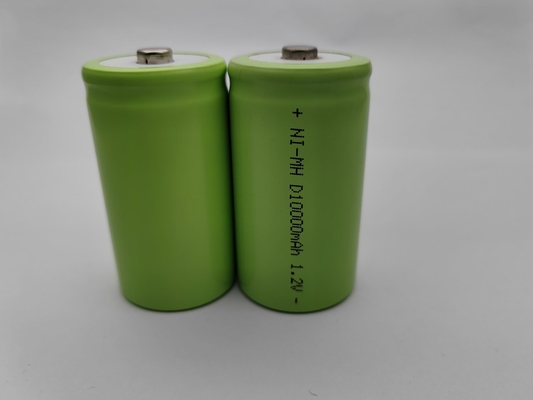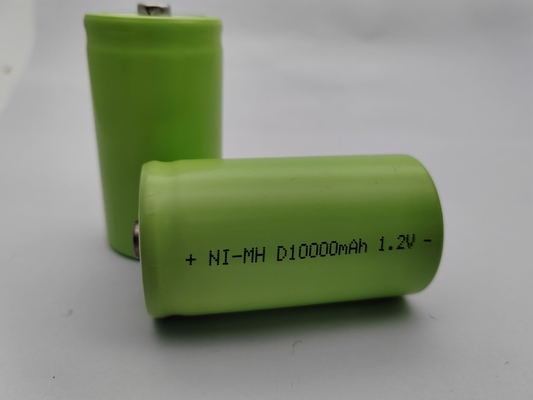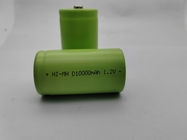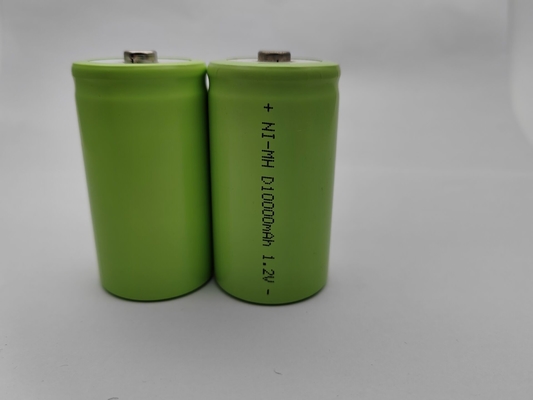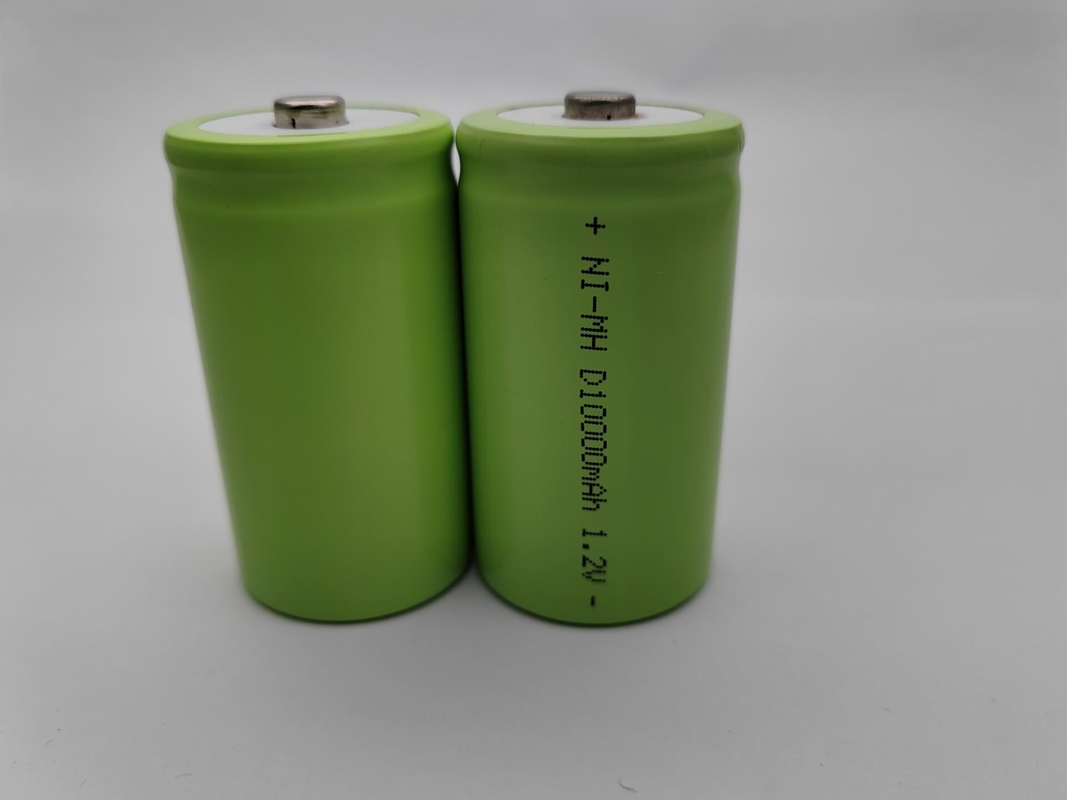D SIZE nickel metal hydride rechargeable batteries 10000 MAH , IEC62133 ,UL,KC CE
Revised record
| No. |
Date |
Edition |
Change content/ |
| 1 |
2023-08-31 |
A0 |
New issue/ |
| |
|
|
|
| |
|
|
|
| |
|
|
|
| |
|
|
|
1. SCOPE
This specification is applied to the reference battery in this Specification and manufactured by .
2. BATTERY MODEL : 60DP10000mAh 1.20V
3. EXTERNAL APPEARANCE
The cell / battery shall be free from cracks, scars, breakage, rust,discoloration, leakage and deformation.
4. NOMINAL SPECIFICATION
| Item |
Unit |
Specification |
Conditions |
| Nominal Voltage |
V |
1.2 |
|
|
Nominal Capacity
|
mAh
|
10000
|
Standard charge/discharge
:
|
| Standard charge |
mA |
1000(0.1C) |
Ta=20±5℃
|
| Hour |
16 |
| Quick Charge |
mA |
2000(0.2C) |
Ta=0-40℃
|
| Hour |
7.0 |
| Rapid Charge |
mA |
5000(0.5C) |
Cut-off condition:
-△V=5mV/cell
dT/dt=0.8~1.0℃/min
|
| Hour |
2.4 |
| Trickle charge |
mA |
0.02C-0.05C |
Ta=0-40℃ |
| Standard discharge |
mA |
2000(0.2C) |
Ta=0-40℃
Humidity:65±20%
cell cutoff:1.0V/cell
|
|
Storage teerature
|
℃
|
-20℃~30 within 1 year
-20℃~40 within 6 month
-20℃~50 within 1 month
-20℃~55 within 1 week
|
Relative humidity:65±20%
|
| Weight |
g |
Approx160.0 |
|
5. ELECTRICAL CHARACTERISTICS
Unless otherwise stated, tests should be done within one month of delivery under the following conditions:
Ambient Teerature:20±5℃ Relative Humidity:65±20%RH
Notes:Standard Charge/Discharge Condition
Charge:1000mA(0.1C)×16 hrs
Discharge:2000mA(0.2C)to 1.0V/ Pack
| 检测项目 |
单位 |
标准 |
条件 |
备注 |
| 5.1 Open circuit voltage |
V
|
≥1.25 |
Within 1 hr after standard charge |
|
| 5.2 Internal iedance |
mΩ
|
≤15 |
Within 1 hr after standard charge |
|
| 5.3 Discharge(0.2C) |
mAh |
≥10000 |
Standard Charge , 1hr rest before discharge |
Allow to 3 cycle |
| 5.4 Discharge(0.5C) |
mAh |
≥9200 |
Standard Charge , 1hr rest before discharge |
Allow to 3 cycle |
| 5.5 High Rate Discharge |
mAh |
≥8800 |
Standard Charge , 1hr rest before discharge |
Allow to 3 cycle |
| 5.6 Overcharge |
N/A |
See note |
0.1C charge for 48 hrs
|
No leakage nor Deformation |
| 5.7 Charge retention 1 |
mAh |
≥6000(60%) |
Standard charge
Storage: 28 days at Ambient Teerature or 7 days at 45℃ Standard discharge
|
|
| 5.8 IEC Cycles Life Test |
Cycles
|
≥500
|
IEC 61951-2(2017)/7.5.1.2
|
(see note 1)
|
|
5.9 Cycles Life Test
|
Cycles
|
200 (≥60%)
|
20±5℃,0.2C charging for 420min, -ΔV=5mv, let it sit for 30 minutes,0.2C discharge to 1.0V
|
|
| 5.10 Over-charge |
N/A |
See note
|
Charge at 0.1C for 48 hours, standard discharge within 1hour. |
No leakage, No deformation |
| 5.11 Forced discharge |
N/A |
See note |
1,Ambient teerature(20±5℃)
2,Discharge the battery to 1.0V at 0.5C
3,Discharge the battery for 10 minutes at 0.5C continuously
|
No fire No explosion |
|
5.12 External
Short circuit
|
N/A |
IEC62133(2017) 7.2.2 |
After standard charge, short circuit the cell 1hour at 20+/-5℃.(The resistance of the inter connecting circuitry shall not exceed 0.1Ω).
|
|
| 5.13 Vibration |
N/A |
IEC62133(2017) 7.2.2 |
IEC62133(2017)7.2.2
See Remark 2
|
No leakage, No fire ,
No explosion
|
| 5.14 Free fall |
N/A
|
IEC62133(2017)7.3.3 b
|
Each fully charged cell or battery is dropped three times from a height of 1 m onto a concrete floor. The cells or batteries are dropped so as to obtain iacts in random orientations. After the test, the sale shall be put on rest for a minimum of 1 h and then a visual inspection shall be performed |
No fire,
No explosion.
|
Notes :
1,Approximate charge time from discharged rate, for reference only IEC 61951-2(2017)7.5.1.2 Cycle Life Test
| Cycle No. |
Charge |
Rest |
Discharge |
| 1 |
0.1C,16h |
None |
0.25 C,2h 20min |
| 2—48 |
0.25 C,3h 10min |
None |
0.25 C,2h 20min |
| 49 |
0.25 C,3h 10min |
None |
0.25 C to 1.0V/cell |
| 50 |
0.1 C,16h |
1h-4h |
0.2 C to 1.0V/cell |
|
Cycle 1 to 50 shall be repeated until the discharges duration on any 50th cycle becomes
less than 3hrs
|
2. Vibration :IEC62133(2017)7.2.2
| Frequency |
10~55Hz |
| Alitude |
0.76mm |
| Rate of frequency variety |
1 Hz/minute |
| Duration |
90 minutes /axis (axis: X,Y,Z) 270 minutes in all |
6,ENVIRONMENTAL PROTECTION REQUIREMENT
6.1 The battery pack would be installed and built into the electrical device, so it shouldn't be regarded as outeral and touchable part.That's to say,the battery pack isn't suitable to the environmental regulations for touchable parts.
6.2 It is hereby certified by , Inc. that there is neither ROHS (EU Directive 2002/95/EC, 2011/65/EU, 2015/863) restricted substance nor such use, for materials to be used for unit parts, for packing/ packaging materials, and for additives and the like in the manufacturing processes.
6.3 Battery Cells restricted substance conform to the requirements of the Battery Directive (EU Directive 2006/66/EC,2013/56/EU)
6.4 Is not responsible for the collection and recycling of the waste battery as required in Battery Directive (EU Directive 2006/66/EC, 2013/56/EU)
6.5 Battery interior constitution
| Never disassemble.Doing so may cause an internal or external short circuit or result in exposed material of battery reacting chemically with the air. It may also cause heat generation, explosion and fire. Also, this is dangerous as it may cause splashing of alkaline fluid. |
 |
6.6 Cell materials and coonents (IMDS 446786133)
| NO Material name |
|
CAS No. |
Proportion[%] |
| 1 Nickel hydroxide |
|
12054-48-7 |
15 - 22 |
| 2 Iron |
|
7439-89-6 |
16 - 20 |
| 3 Nickel |
|
7440-02-0 |
30 - 40 |
| 4 Manganese |
|
7439-96-5 |
0.3 - 1.5 |
| 5 Lanthanum |
|
7439-91-0 |
1.7 - 4.5 |
| 6 Cobalt |
|
7440-48-4 |
1.5 - 2.5 |
| 7 Potassium-hydroxide |
|
1310-58-3 |
1 - 2 |
| 8 Polyethylene |
|
9002-88-4 |
0 - 0.6 |
| 9 Cerium |
|
7440-45-1 |
0.29 - 0.9 |
| 10 Neodymium |
|
7440-00-8 |
0 - 1 |
| 11 Aluminium (metal) |
|
7429-90-5 |
0 - 1 |
| 12 Sodium-hydroxide |
|
1310-73-2 |
1 - 2 |
| 13 Lithium-hydroxide |
|
1310-65-2 |
0.1 - 0.5 |
| 14 PTFE |
|
9002-84-0 |
0 - 0.1 |
| 15 CMC |
|
9004-32-4 |
0 - 0.1 |
| 16 Polypropylene |
|
9003-07-0 |
1 - 3 |
| 17 SBR |
|
9003-55-8 |
0.1 - 0.5 |
| 18 Cobalt hydroxide |
|
21041-93-0 |
0.5 - 2 |
| 19 Zinc-hydroxide |
|
20427-58-1 |
0 - 0.1 |
| 20 Water |
|
7732-18-5 |
0.15 - 0.23 |
7.TRANSPORT
Mode of transport: air, sea and road
|
Transport hazard class(es)
l ADR/RID/AND, IATA
l Class
l Label
|
Not applicable
-
|
|
l IMDG
l Class
l Label
|
9 miscellaneous dangerous substances 9
|
and
|
articles.
|
|
Packing group
l ADR/RID/AND, IMDG
l IATA
|
-
Not applicable
|
| Environmental hazards |
Not applicable |
|
Special precautions for user:
l Danger code(Kemler):
l EMS Number:
l Stowage Category
l Stowage Code
|
Not applicable
-
F-A,S-I A
SWI Protected from sources of heat.
|
| Transport in bulk according to AnnexⅡof Marpol and the IBC Code |
Not applicable |
Transport information: Nickel-metal hydride Battery is exet from dangerous goods. It is considered non- dangerous goods by the International Civil Aviation Organization(ICAO), the International Air Transport Association(IATA) DGR 63th IATA Special Provisions A199, International Martine Dangerous Goods Regulations(IMDG)(39-18), IMDG Special Provisions 963,or the < Recommendations on the Transport of Dangerous Goods Model Regulations>(22th).
S.P.A199 The UN number UN 3496 is only applicable in sea transport. Nickel-metal hydride batteries or nickel-metal hydride battery-coanyed devices, equipment or vehicles having the potential of a dangerous evolution of heat are not subject to these Regulations provided they are prepared for transport so as to prevent:
(a) a short-circuit (e.g. in the case of batteries, by the effective insulation of exposed terminals; or, in the case of equipment, by disconnection of the battery and protection of exposed terminals);
(b) unintentional activation.
The words “Not Restricted" and the Special Provision number must be included in the description of the substance on the Air Waybill as required by 8.2.6, when an Air Waybill is issued.
Separate batteries when shipping to prevent short-circuiting. They should be packed in strong packaging for support
Note: A total quantity less than 100kg gross mass in a cargo transport unit. (By sea).
Please keep in mind the following points when designing and manufacturing equipment. Please insert in your instruction manual. To prevent equipment malfunctions from affecting the batteries, be sure to use protection devices for electrical circuits and batteries.
△! Danger
Failure to carefully observe the following procedures and precautions can result in leakage of battery fluid (electrolyte), heat generation, explosion, fire and serious personal injury!
Never dispose of batteries in a fire or heat them.
Do not connect the (+) positive and (-) negative terminals of batteries together with electrically conductive materials, including lead wires. Do not transport or store batteries with their uncovered terminals or connected with a metal necklace or other electrically conductive material. When carrying or storing batteries, use a special case.
Never disassemble batteries. Doing so may cause an internal or external short circuit or
result in exposed material of battery reacting chemically with the air. It may also cause heat generation, explosion and fire. Also, this is dangerous as it may cause splashing of alkaline fluid.
Never solder lead wires directly on to batteries.
The (+) positive and (-) negative terminals of batteries are predetermined. Do not force the terminals to connect to a charger or equipment. If the terminals cannot be easily connected to the charger or the equipment, check if the (+) and (-) terminals are incorrectly positioned.
The gas release vent which release internal gas is located in the (+) positive terminal of the
battery. For this reason, never deform this section or cover or obstruct its gas release structure.
Do not connect the battery directly to the DC power supply or to the vehicle power supply.
Batteries contain a strong colorless alkaline solution (electrolyte). The alkaline solution is extremely corrosive and will cause skin damage. If any fluid from a battery comes in contact with user’s eyes, they should immediately flush their eyes and wash them thoroughly with clean water from the tap or another source and consult a doctor urgently. The strong alkaline solution can damage eyes and lead to permanent loss of eyesight.
When batteries are to be incorporated in equipment or housed within a case, avoid air-tight structures, as this may lead to the equipment or the case being damaged or may be harmful to users.
△! Warning
Do not apply water, seawater or other oxidizing reagents to batteries, as this can cause rust and heat generation. If a battery becomes rusted, the gas release vent may no longer operate, and can result in explosion.
Do not over-charge batteries by exceeding the predetermined charging period specifiedby the battery charger’s instructions or indicator. If batteries are not fully charged after the battery charger’s predetermined charging period has elapsed, stop the charging process. Prolonged charging may cause leakage of battery fluid, heat generation, and explosion. Be sure to handle recharged batteries carefully as they may be hot.
Batteries contain a strong colorless alkaline solution (electrolyte).If the skin or clothing comes in contact with fluid from a battery; thoroughly wash the area immediately with clean water from the tap or another source. Battery fluid can irritate the skin.
Do not connect more than 21 batteries in series, as this may cause electrical shocks,leakage of battery fluid and heat generation.
Do not remove the outer tube from a battery or damage it. Doing so will expose the battery to the risk of a short circuit, and may cause leakage of battery fluid, heat generation, explosion and fire.
If batteries leak fluid, change color, change shape, or change in any other way, do not use them, otherwise they may cause heat generation, explosion and fire.
Keep batteries and the equipment using them out of the reach of babies and small children, in order to avoid accidental swallowing of the batteries. In the event the batteries are swallowed, consult a doctor immediately.
When the operating time of a battery becomes much shorter than its initial operating time
even after recharged, it should be replaced to a new battery as its battery life has ended.
△! CAUTION
Do not strike or drop batteries.
Store batteries out of the reach of babies and small children. When charging or using a battery, do not let babies or small children remove the battery from the charger or the equipment being used.
Be sure to charge batteries within a teerature range of 0 to 40 deg C (degrees Celsius).
Be sure to use the recommended charging method for batteries read the battery charger’s instruction manual carefully.
Do not use or store battery at high teerature, such as in strong direct sunlight, in cars during hot weather, or directly in front of a heater. This may cause leakage of battery fluid. It could also iair performance and shorten operating life of batteries.
Be sure to turn off the equipment after use of batteries, otherwise may result in leakage
of battery fluid.
After removed from equipment, store batteries in a dry place and within the recommended storage teerature range. This will help preserve the batteries’ performance and durability and minimize the possibility of leakage of battery fluid or corrosion. (battery recommends the storage teerature range from -20 to +30deg.(for longer service life).
Storage batteries should be charged one time every four months under the storage teerature of 30℃ and below, every three months under 40℃ and below, and every one month under 50℃ and below.
After long term storage, there is a possibility that the battery could not be fully charged. In order to fully charge it, please charge and discharge battery for a few times.
Do not use old and new batteries mixed together, or batteries at different charge levels. Do not use the battery mixed with a dry cell or other batteries of different capacity, type, or brand name. This may cause leakage of battery fluid and heat generation.
If the battery terminals become dirty, clean up them with a soft dry cloth prior to use. Dirt
on the terminals can result in poor contact with the equipment, loss of Coany, or inability to charge.
9. BATCH ACCEPTANCE
The saling procedure shall be established in accordance with IEC61951-2:2017 10.3 table 34. Unless otherwise agreed between supplier and purchaser, inspections and tests shall be performed using inspection levels and AQLS (acceptable quality level) recommended in table as follow:
|
Group
|
Clause or sub clause
|
Inspection/tests
|
Recommendation |
| Inspection level |
AQL
%
|
|
A
|
As agreed
|
Visual inspection
– absence of mechanical damage
– absence of corrosion on case and terminals
– number, position and secure fittings of connection tabs
– absence of liquid electrolyte on case and
terminals
|
II II
S3
II
|
4
4
1
0.65
|
|
B
|
Clause 6 As agreed
5.3
|
Physical inspection
– dimensions
– marking
|
S3 S3
|
1
1
|
|
C
|
7.3.2
7.3.2
|
Electrical inspection
– open-circuit voltage and polarity
– discharge at 20 °C at 0,2 It A 0.2C
|
II S3
|
0.65
1
|
| NOTE Two or more failures on a single cell are not cumulative. Only the failure corresponding to the lowest AQL is taken into consideration. |
10. WARRANTY
The battery packs are warranted 12 months from the ex-factory date.
Warranty shall not be applicable in the cases where customer iroperly handle, operate, test, install, service and disassemble the battery packs or fails to follow the instructions, cautions, warnings, notes provided in the specifications.


 Your message must be between 20-3,000 characters!
Your message must be between 20-3,000 characters! Please check your E-mail!
Please check your E-mail!  Your message must be between 20-3,000 characters!
Your message must be between 20-3,000 characters! Please check your E-mail!
Please check your E-mail! 
